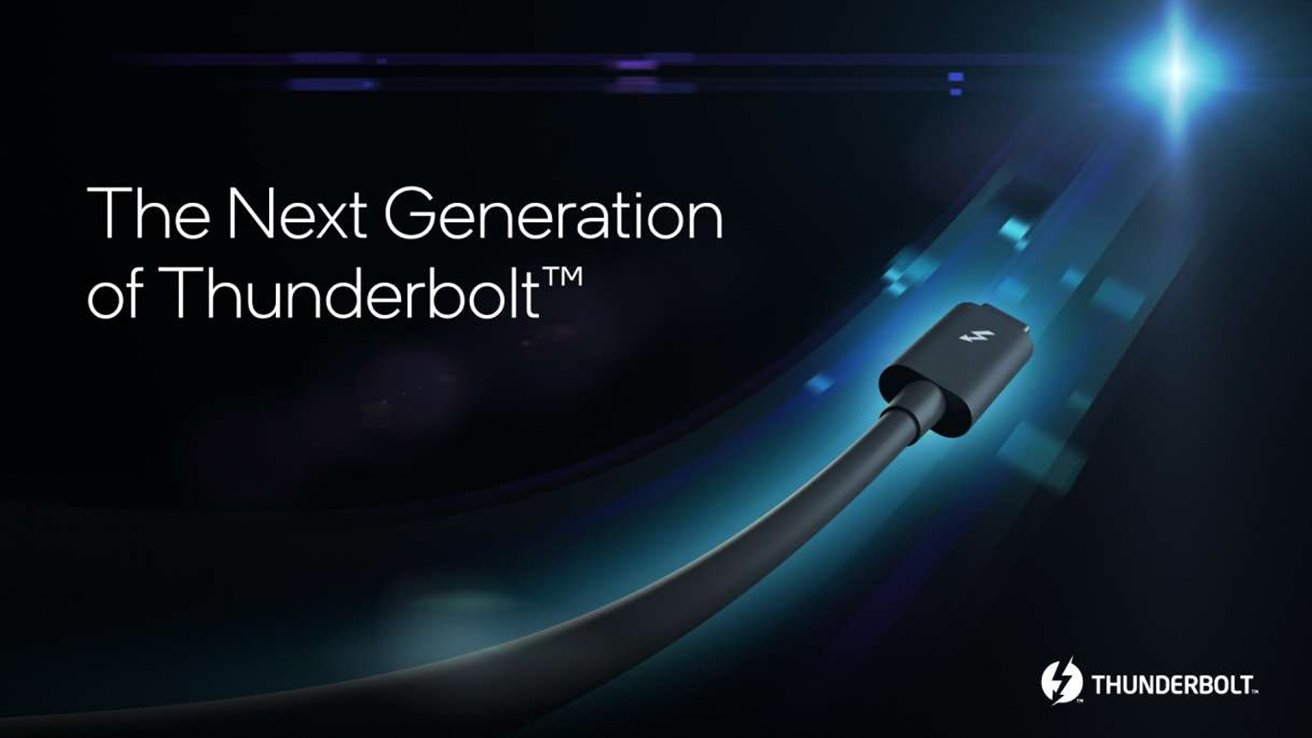Intel's Thunderbolt 5 has twice the speed of Thunderbolt 4
Intel has previewed an early prototype for its next-generation Thunderbolt, showcasing faster speeds and improved external display support.

The next generation of Thunderbolt will deliver 80 gigabits per second of bidirectional bandwidth, double that of Thunderbolt 4. The increased speed would be beneficial for transferring large files from one device to the next.
Intel says that it will dynamically enable up to 120 Gbps bandwidth for external displays, which is three times higher than that of its predecessor. This will allow for 8K HDR displays with lower latency, ideal for creative professionals and gaming enthusiasts.
The company also promises "2x faster SSDs for portable gaming" with the technology. This will require new enclosures, as existing external drive controllers are limited to the existing 40 gigabit per second speeds.
"Intel has always been the industry pioneer and leader for wired connectivity solutions, and Thunderbolt is now the mainstream port on mobile PCs and integrated into three generations of Intel mobile CPUs," Intel's General Manager of Client Connectivity Jason Ziller said in a statement. "We're very excited to lead the industry forward with the next generation of Thunderbolt built on the USB4 v2 specification, advanced to this next generation by Intel and other USB Promoter Group members."
In addition to increased speeds, Next Gen Thunderbolt provides support for the newly released DisplayPort 2.1, two times the PCI Express data throughput, and is backward compatible with previous versions of Thunderbolt, USB, and DisplayPort.
Intel says that the new technology will work with existing passive cables up to one meter in length with a "new signaling technology." It's not clear yet what longer cables will need, but Intel was specific about existing passive cables, and not active, longer ones already on the market.
Nothing Intel is discussing alters the existing cable confusion inherent in the USB-C physical connector. Instead, it is another variant using the same cable connector Without USB-IF mandates, it will likely exacerbate the problem.
Intel will share more information on the next generation of Thunderbolt, as well as its capabilities and features, in 2023. It's not clear when Apple might introduce the spec -- but it is typically on the forefront of Thunderbolt releases.
Read on AppleInsider

The next generation of Thunderbolt will deliver 80 gigabits per second of bidirectional bandwidth, double that of Thunderbolt 4. The increased speed would be beneficial for transferring large files from one device to the next.
Intel says that it will dynamically enable up to 120 Gbps bandwidth for external displays, which is three times higher than that of its predecessor. This will allow for 8K HDR displays with lower latency, ideal for creative professionals and gaming enthusiasts.
The company also promises "2x faster SSDs for portable gaming" with the technology. This will require new enclosures, as existing external drive controllers are limited to the existing 40 gigabit per second speeds.
"Intel has always been the industry pioneer and leader for wired connectivity solutions, and Thunderbolt is now the mainstream port on mobile PCs and integrated into three generations of Intel mobile CPUs," Intel's General Manager of Client Connectivity Jason Ziller said in a statement. "We're very excited to lead the industry forward with the next generation of Thunderbolt built on the USB4 v2 specification, advanced to this next generation by Intel and other USB Promoter Group members."
In addition to increased speeds, Next Gen Thunderbolt provides support for the newly released DisplayPort 2.1, two times the PCI Express data throughput, and is backward compatible with previous versions of Thunderbolt, USB, and DisplayPort.
Intel says that the new technology will work with existing passive cables up to one meter in length with a "new signaling technology." It's not clear yet what longer cables will need, but Intel was specific about existing passive cables, and not active, longer ones already on the market.
Nothing Intel is discussing alters the existing cable confusion inherent in the USB-C physical connector. Instead, it is another variant using the same cable connector Without USB-IF mandates, it will likely exacerbate the problem.
Intel will share more information on the next generation of Thunderbolt, as well as its capabilities and features, in 2023. It's not clear when Apple might introduce the spec -- but it is typically on the forefront of Thunderbolt releases.
Read on AppleInsider

Comments
A pro certain probably could, writing multiple streams of 8K video (or other data) to a disk array with multiple NVMe drives. TB5 is intended more for that professional audience; Thunderbolt compatible hardware is already expensive.
In any case, TB5 is still in the proposal stage. Once it's approved in its final form, there would be more activity to develop compliant hardware.
Up until now, Thunderbolt has essentially been an externalization of the PCIe bus as far as I can tell. As PCIe bus bandwidth increases, Thunderbolt follows.
Apple’s original involvement was developing DisplayPort support and adapting Light Peak to support both optical cable and copper cable. To answer July’s question above, I don’t think Apple’s role is any different from the rest of the industry at this point. Here’s an early AI article about it:
https://appleinsider.com/articles/11/02/24/intel_details_thunderbolt_as_exclusive_to_apple_until_2012
If 80 Gbit/s TB is available, they could do multistream 5K and 6K where you just need one cable to power 2 5K or 6K monitors, and perhaps have enough bandwidth leftover for an external SSD at 30 Gbit/s (3 Gbyte/s).